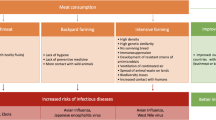Summary
An estimate of the economic loss due to ovine fasciolosis in the Ethiopian highlands was made based on available data on mortality, weight loss, reduced reproductive efficiency and liver condemnation at slaughter. The economic effects of fasciolosis were identified and models for estimating the financial loss presented. Ovine fasciolosis losses were estimated at 48·4 million Ethiopian Birr per year of which 46·5, 48·8 and 4·7% were due to mortality, productivity (weight loss and reproductive wastage) and liver condemnation, respectively. These losses can be reduced substantially by fasciolosis control programmes that may include the use of anthelmintics, grazing management and nutritional supplementation.
Résumé
Une estimation de la perte économique due à la fasciolose ovine dans les Highlands d'Ethiopie a été faite sur la base de données disponibles sur la mortalité, la perte de poids, la réduction de l'efficacité de reproduction et la saisie de foies à l'abattage. Les effects économiques de la fasciolose ont éte identifiés et des modèles pour l'estimation des pertes financières ont été présentés.
Les pertes dues à la fasciolose ovine ont été estimées à 48,4 millions de Birrs éthiopiens par an, dont 46,5, 48,8 et 4,7 p. 100 étaient dus respectivement à la mortalité, la productivité (la perte de poids et la perte de reproduction) et à la saisie de foies.
Les pertes peuvent être réduites de façon substantielle à l'aide de programmes de lutte contre la fasciolose pouvant inclure l'utilisation d'anthelminthiques, la gestion des pâturage et une complémentation alimentaire.
Resumen
Se llevo a cabo un cálculo de las pérdidas economicas causadas por fasciolosis en la tierras altas de Etiopia, basado en información sobre mortalidad, perdidas de peso, reducción de la eficacia reproductora y decomisos de higados en el matadero. Se identificaron los efectos económicos de la enfermedad, presentándose modelos para estimar dichas perdidas económicas. Las pérdidas por fasciolosis ovina fueron estimadas en 48·4 millones de Birr/ano, des los cuales 46·5, 48·8 y 4·7% se debieron a mortalidad, productividad (pérdidas de peso e ineficacia reproductora) y decomiso de hígados, respectivamente. Estas pérdidas pueden reducirse sustancialmente instaurando programas de control con antihelmínticos, manejo de praderas y suplementación nutricional.
Similar content being viewed by others
References
Agyemang, K., Negussie, A., Voorthuizen, A. &Anderson, F. M. (1985). A report on a production survey of farmers' sheep flocks in Debre Berhan area of the Ethiopian highlands. Highland Programme Working Paper, ILCA, Addis Ababa, Ethiopia.
Andargachew, K. (1990). Sheep Marketing in the Central Highlands of Ethiopia. Unpublished MSc. Thesis. Alemaya University of Agriculture, Alemaya, Ethiopia.
Bekele, T., Kasali, O. B. &Woldemariam, W. (1992). Endoparasite prevalence of the highland sheep in Ethiopia.Preventive Veterinary Medicine,13, 93–102.
Berry, C. I. &Dargie, J. D. (1976). The role of host nutrition in the pathogenesis of ovine fasioliasis.Veterinary Parasitology,2, 317–332.
Fabiyi, J. P. &Adeleye, G. A. (1982). Bovine fascioliasis on the Jos Plateau, Northern Nigeria with particular reference to economic importance.Bulletin of Animal Health and production in Africa,30, 41–43.
Gemechu, B. &Mamo, E. (1979). A preliminary survey of bovine fascioliasis in Ethiopia.Ethiopian Journal of Agricultural Sciences,1, 5–12.
Graber, M. (1975). Helminths and helminthiasis of different domestic and wild animals of Ethiopia.Bulletin of Animal Health and Production in Africa,23, 57–86.
Gryseels, G. (1988). Role of Livestock on Mixed Smallholder Farms in the Ethiopian Highlands: A Case Study from the Baso and Worena Wereda near Debre Berhan. PhD dissertation, Agricultural University, Wageningen, The Netherlands.
Hamminga, B. J. (1989). The effect of nematode and trematode infections in the growth performance of Ethiopian highland sheep. ILCA, Addis Ababa. Ethiopia.
ILCA (International Livestock Centre for Africa) (1989). ILCA Annual Report 1988. Addis Ababa, Ethiopia.
ILCA (International Livestock Centre for Africa) (1991). ILCA Annual Report 1990. Addis Ababa, Ethiopia.
Jacinta, E. (1983). Investigations on Fascioliasis in the Ethiopian Highlands around Debre Berhan. MSc Thesis. Institute of Tropical Medicine and Parasitology, Leiden University, The Netherlands. pp 1–29.
Kassahun, A. (1985). The status of sheep and goat research in Ethiopia. Institute of Agricultural Research, Addis Ababa, Ethiopia.
Mamo, B., Shibru, T. &Fisseha, G. (1982). Survey of gastro-intestinal helminths in sheep slaughtered at Addis Ababa abattoir.Ethiopian Journal of Agricultural Sciences,4, 87–93.
Mukhebi, A. W., Shavulimo, R. S., Ruvuna, F. &Rurangirwa, F. (1985). Economics of internal parasitic control among goats in Western Kenya. Paper Presented at the Fourth Small Ruminant Collaboration Research Programme Kenya Workshop. March 11 and 12 1985, Kenya.
Mulugeta, H. S., Getachew, T., Tafesse, M., Getachew, W. M., Kinfe, G. &Tehsome, Y. (1989). The significance of helminth parasites in livestock production. Paper presented at the Third Livestock Improvement Conference held in Addis Ababa, Ethiopia. 24 to 26 May.
Muenstermann, S. &Tome, N. R. (1989). Influence of regular tick and helminth control on productivity of small ruminants in the Lolgorien area, Narok district, Kenya.Tropical Animal Health and Production,21, 247–255.
Ngategize, P. K., Zere, Azaz &Brokken, R. F. (1990). Economics of endoparasitic control and nutritional supplementation in the Ethiopian highlands. Paper presented at the Eighth Small Ruminant Collaboration Research Support Programme Scientific Workshop, ILRAD, Nairobi, 7 to 8 March 1990.
Njau, B. C., Kasali, O. B., Scholtens, R. G. &Mesfin, D. (1988a). Review of sheep mortality in the Ethiopian highlands, 1982–1986.ILCA Bulletin, Addis Ababa, Ethiopia.31, 19–22.
Njau, B. C., Kasali, O. B., Scholtens, R. G. &Mesfin, D. (1988b). Field and laboratory studies of causes of sheep mortality in the Ethiopian highlands 1986/1987.ILCA Bulletin, Addis Ababa, Ethiopia.31, 23–26.
Ogunrinade, A. &Ogunrinade, B. I. (1980). Economic importance of bovine fascioliasis in Nigeria.Tropical Animal Health and Production,12, 155–160.
Scott, J. M. &Goll, P. H. (1977). The epidemiology and anthelmintic control of ovine fascioliasis in the Ethiopian central highlands.British Veterinary Journal,133, 273–280.
Tilahun, G. (1987). A survey of fascioliasis in cattle, sheep and goats slaughtered at Addis Ababa Abattoir, Ethiopia. Institute of Pathobiology (IPB) Research Report No. 3, Addis Ababa, Ethiopia. pp 10–11.
Author information
Authors and Affiliations
Rights and permissions
About this article
Cite this article
Ngategize, P.K., Bekele, T. & Tilahun, G. Financial losses caused by ovine fasciolosis in the Ethiopian highlands. Trop Anim Health Prod 25, 155–161 (1993). https://doi.org/10.1007/BF02236234
Accepted:
Issue Date:
DOI: https://doi.org/10.1007/BF02236234




